Discover 15 hidden attractions, cool sights, and unusual things to do in Martinsburg (United States). Don't miss out on these must-see attractions: Aspen Hall, Apollo Theatre, and Van Metre Ford Stone Bridge. Also, be sure to include Adam Stephen House in your itinerary.
Below, you can find the list of the most amazing places you should visit in Martinsburg (West Virginia).
Table of Contents
Aspen Hall
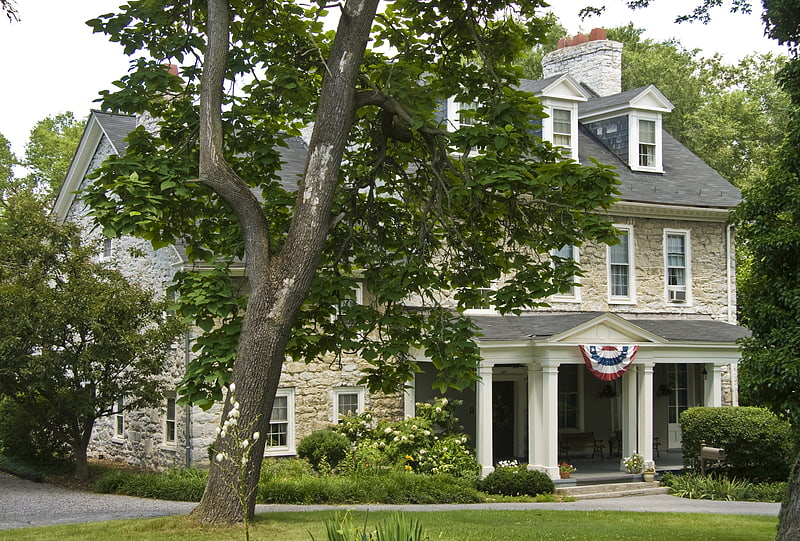
Aspen Hall, also known as the Edward Beeson House, was built beginning in 1771 as a stone house in the Georgian style in what would become Martinsburg, West Virginia. The first portion of the house was a 20 by 20 foot "fortified stone home", 2½ stories tall. in coursed rubble limestone built in 1745 by Edward Beeson I. It is the oldest house in Martinsburg.
The Georgian block of the house was built by Edward Beeson II, a wealthy Quaker farmer and miller. Beeson died in 1817 and the house was sold to Mathew Ranson of Jefferson County in 1821, who then sold it to Union Colonel John W. Stewart in 1850. The house remained in the Stewart family until 1926.
Aspen Hall is notable for its outstanding entrance hall, measuring 13 feet (4.0 m) wide and 36 feet (11 m) deep. The original interior was laid out in a side hall arrangement, two rooms deep. The principal interior rooms are paneled. About 1900 the house was altered to make what had been the rear entrance the front, and Victorian details were added.
The property includes the blockhouse of Mendenhall's Fort, built about 1755 by John Mendenhall, brother of Edward Beeson I's widow. There was a wooden stockade that extended from the blockhouse to surround Mendenhall's and Beeson's homes. Mendenhall's home was also built in 1755, making it the second oldest house in Martinsburg. The fort was built to defend the area against Native American attack during the French and Indian War. The fortification was noted by George Washington in a communication to Colonel William Fairfax in 1757. Col. Washington garrisoned troops at Mendenhall's several times. House of Burgesses candidate Washington attended a wedding at "Mendenhall's Mill" in 1761.
The property was placed on the National Register of Historic Places in 1980, and is included in the Boyd Avenue Historic District.[1]
Address: 405 Boyd Avenue, Martinsburg
Apollo Theatre
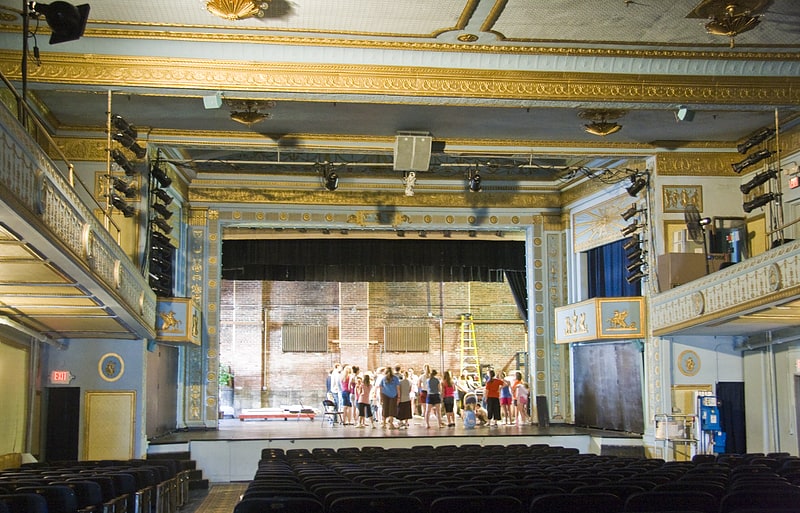
Theater in Martinsburg, West Virginia. The Apollo Theatre in Martinsburg, West Virginia was designed by architect Reginald Geare with local architect Chapman E. Kent, and built in 1913 by theater owner H. P. Thorn. As constructed it had a seating capacity of 1000, and was used for movies, vaudeville and concerts. Upper floors provided meeting spaces for large groups.
The Apollo Theatre is operated as a community-supported facility. It was listed on the National Register of Historic Places in 1979. It is included in the Downtown Martinsburg Historic District.[2]
Address: 128 E Martin St, 25401-4306 Martinsburg
Van Metre Ford Stone Bridge
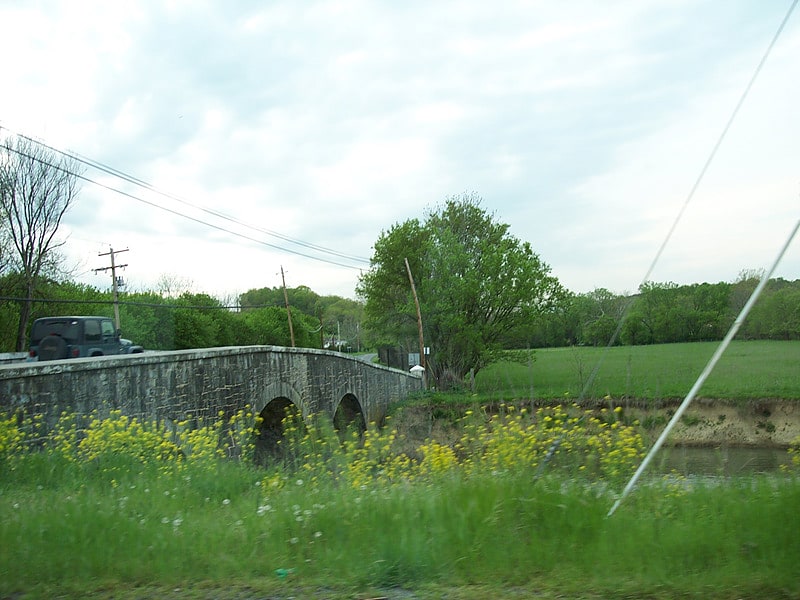
Arch bridge in Berkeley County, West Virginia. Van Metre Ford Stone Bridge is a historic stone arch bridge located near Martinsburg, Berkeley County, West Virginia. Built by Pennsylvania builder Silas Harry, it was built in 1832, and is a three span bridge crossing Opequon Creek. It is 132 feet long and constructed of ashlar limestone. The center span measures 32 feet and the two side spans are each 29.5 feet long.
It was listed on the National Register of Historic Places in 1977. A historic marker at the bridge says:
Named for the property owners this stone bridge built in 1832 across Opequon Creek was major improvement for travellers on Warm Springs Road connecting Alexandria and Bath Va. site of famous mineral waters. The Berkeley County Court established a commission to study and contract for construction of bridge. Silas Harry erected at local expense 165 foot bridge at reported cost of $3,700.
The bridge was replaced by a modern, two-lane bridge in 2016. The historic stone bridge remains as a pedestrian bridge.[3]
Adam Stephen House

Museum in Martinsburg, West Virginia. Adam Stephen House is a historic home located at Martinsburg, Berkeley County, West Virginia. It was built between 1772 and 1789, and is a 2+1⁄2-story, stone house measuring 43 feet, 5 inches, by 36 feet, 3 inches. It was the home of Adam Stephen. Built of shaped limestone, it stands on a prominent stone ledge, with two outbuildings in stone and log. After falling into near-ruin, iIt was restored in the 1960s by the General Adam Stephen Memorial Association and is open as a historic house museum. The house was built over a natural cave, with stone steps leading down from the basement. A local caver's organization has worked since 2002 to excavate the cave, which had become plugged with earth, and the excavation is available for tours on open house days.
The site also includes the Triple Brick House, a brick two-story building built into the embankment next to the railroad tracks that run close to the site. It was built about 1875, and was primarily for residential use, but may also have been a kitchen for dining cars on the B&O railroad line.
It was listed on the National Register of Historic Places in 1970. It is located within the South Water Street Historic District, listed in 1980.[4]
Address: 309 E John St, 25401-4218 Martinsburg
For the kids
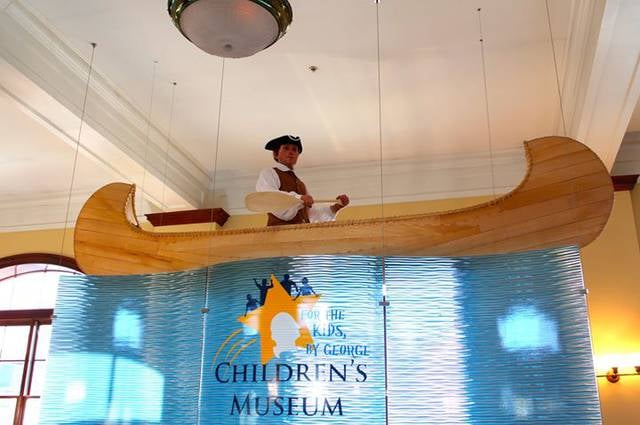
Specialty museum, Museum
Address: 229 E Martin St, 25401-4304 Martinsburg
Mount Zion Baptist Church
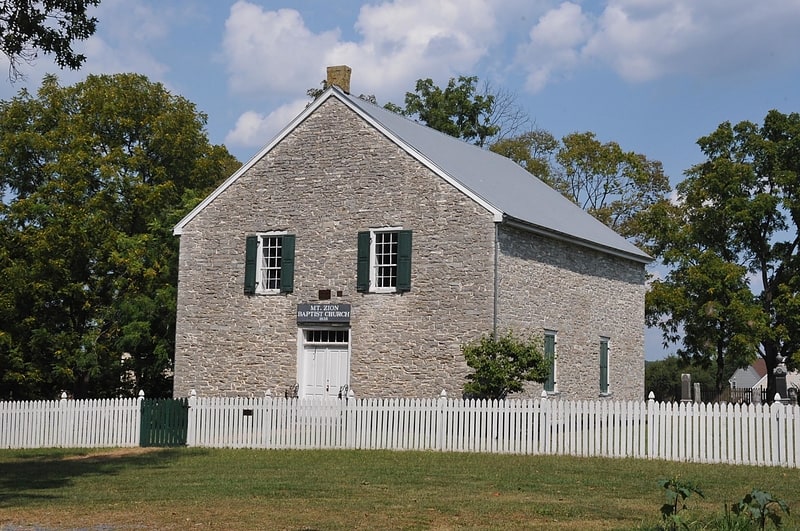
Church in Kearneysville, West Virginia. Mount Zion Baptist Church is a historic church on Opequon Lane in Martinsburg, West Virginia.
Built during 1836–38, 35 by 40 square feet (3.3 m2 × 3.7 m2) in plan, with stonework "unequalled" in Berkeley County. As of 1980 the church was in use only about once yearly.
It was added to the National Register of Historic Places in 1980.[5]
Wonderment Puppet Theater

Concerts and shows, Theater
Address: 412 West King Street, 25401-3204 Martinsburg
South Water Street Historic District
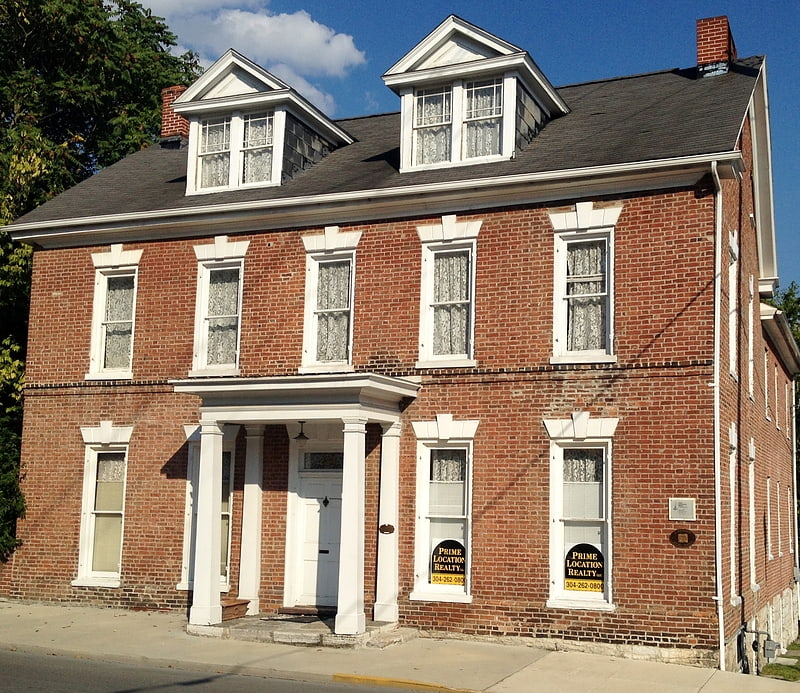
South Water Street Historic District is a national historic district located at Martinsburg, Berkeley County, West Virginia. It encompasses 30 contributing buildings and one contributing site, related to residential, commercial, and economic development along the Tuscarora Creek. Notable buildings include: the Edison Electric Illumination Company of Martinsburg building; dwellings along South Water Street at 104–106, 108, 119, 120, 200, 202, 208, 216, and 308; rowhouses at 222, 224, and 226; the O'Hara-Martin House; the Alburtis House; the South Water Street Stone House; the Martinsburg Steam Laundry Company building; and Martinsburg Gas Company Complex. Also located in the district is the separately listed General Adam Stephen House.
It was listed on the National Register of Historic Places in 1980.[6]
Downtown Martinsburg Historic District

Downtown Martinsburg Historic District is a national historic district located at Martinsburg, Berkeley County, West Virginia. It encompasses 281 contributing buildings. It includes government and industrial buildings, several schools, firehouses, and churches, the two main commercial and professional areas along Queen and King Streets, a major hospital, and surrounding residential areas. The buildings reflect a number of popular 19th-century architectural styles including Gothic Revival, Italianate, and Queen Anne.
It was listed on the National Register of Historic Places in 1980.[7]
Boydville Historic District

Historical landmark in Martinsburg, West Virginia. The Boydville Historic District includes an area of Martinsburg, West Virginia that was developed for the well-to-do of Martinsburg at the turn of the twentieth century. The district is named for Boydville, the mansion at the core of the district. The district runs generally along South Queen Street to the south of the Downtown Martinsburg Historic District and to the east of the Boomtown Historic District.
The district is associated with a number of figures from the early history of Martinsburg, including General Elisha Boyd, who owned portions of the area in the 1790s, as well as General Adam Stephen, founder of Martinsburg. The principal building in the area is the Boydville mansion, built about 1812. Other significant buildings include the Public Graded School of 1883, now the headquarters for the Berkeley County Board of Education, the Classical Revival 517 South Queen Street, and the Adam Stephen Monument.
The district was listed on the National Register of Historic Places in 1980.[8]
Boomtown Historic District
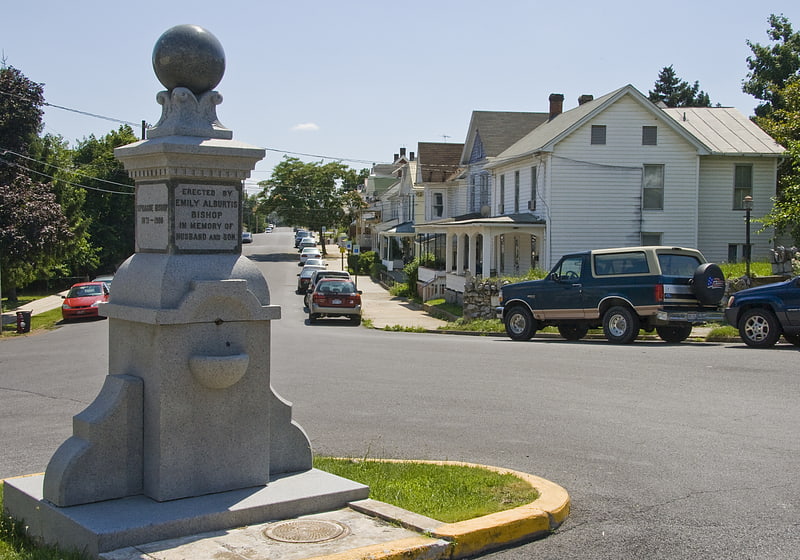
Building in Martinsburg, West Virginia. The Boomtown Historic District comprises the western and southern portions of Martinsburg, West Virginia, generally along the alignments of West King Street and Winchester Avenue, following the general path of the town's electric streetcar system. It includes a former industrial section of the town, home to a number of textile mills, as well as the housing that was built for mill workers.
Boomtown's central core is along Virginia, West Virginia and Faulkner Avenues, centering on the fountain at Virginia and Faulkner. The area consists of primarily middle-class Victorian-style houses, in contrast to the more modest working-class houses on the opposite side of Winchester Avenue. The greatest building activity took place after 1891, when the Martinsburg Mining and Manufacturing Company developed the area in conjunction with the opening of streetcar service.
Industrial buildings include the former homes of the Shenandoah Pants Company, Brooklyn Brass Works and the Interwoven Mills. The Crawford Woolen and Cashmere Mills stand along Stephen Street.
The area was designated a historic district in 1980. It includes the separately-listed Abell-Kilbourn House.[9]
John Evans House
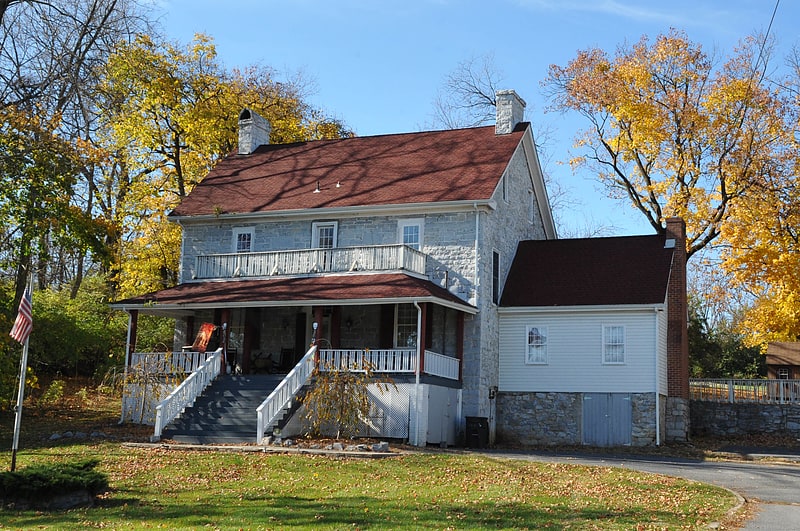
Historical landmark in Berkeley County, West Virginia. John Evans House, also known as Big Spring Farm, is located in Martinsburg, West Virginia. It was listed on the National Register of Historic Places in 2006.[10]
East Martinsburg Historic District
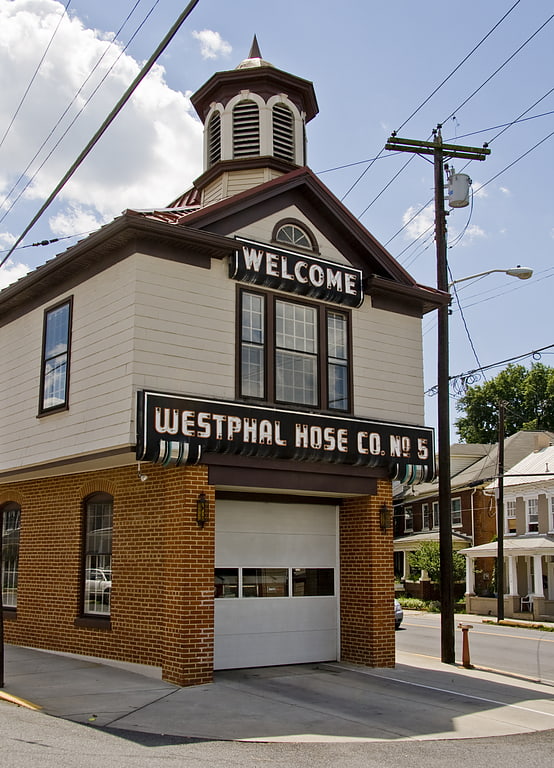
Historical landmark in Martinsburg, West Virginia. The East Martinsburg Historic District is associated with the growth of Martinsburg, West Virginia during the 1850s, when the development of the Baltimore and Ohio Railroad brought German and Irish settlers to the area. The district includes areas known as Buena Vista, Chevally City, St. Vincent, Hooge's Addition, Small's Addition, Carver's Addition, Mohler's Addition, Strinesville and East Strinesville.
The oldest sections of the district have concentrations of pre-Civil War buildings in the Greek Revival style, while later sections include Gothic Revival, Queen Anne and Classical Revival buildings.
The district was listed on the National Register of Historic Places in 1980.[11]
Federal Aviation Administration Records Center
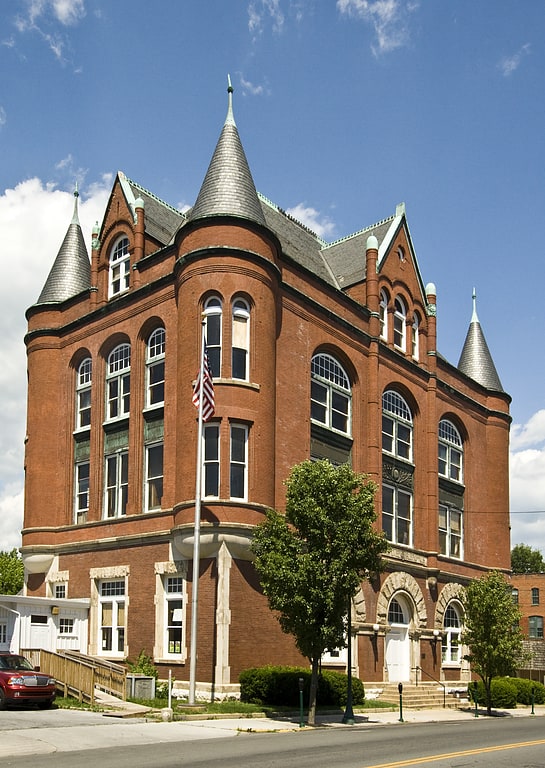
Courthouse. The Federal Aviation Administration Records Center in Martinsburg, West Virginia is the former United States Courthouse and Post Office for the city. It is a Richardson Romanesque style building, principally designed by Willoughby J. Edbrooke, of the Office of the Supervising Architect. It was used as a federal courthouse and post office from 1895 to 1961, when both functions moved across the street to a new facility. The building to some extent resembles Henry Hobson Richardson's now-destroyed Cincinnati Chamber of Commerce Building.
The Federal Aviation Administration occupied the building in 1970, primarily as an emergency relocation center for Washington-based operations, then vacated the building in the 1990s. The blast-resistant construction and communications facilities are still visible in the basement. During the Cold War, the Justice Department and essential operations staff of the Federal Bureau of Investigation planned to use the building's top floors as an emergency relocation center.
The building was partly renovated as an arts center. It is part of the Downtown Martinsburg Historic District and was listed on the National Register of Historic Places in 1974.[12]
Baltimore and Ohio and Related Industries Historic District

Historical landmark in Martinsburg, West Virginia. The Baltimore and Ohio Related Industries Historic District comprises a portion of Martinsburg, West Virginia to either side of the Baltimore and Ohio Railroad line as it runs through the city. The district includes the Baltimore and Ohio Railroad Martinsburg Shops, a National Historic Landmark, and a variety of industrial and commercial concerns that depended on the railroad.
Along with buildings, the district includes the infrastructure associated with the building of the railroad in an urbanizing environment, such as the channelizing of Tuscarora Creek and a variety of culverts, underpasses and retaining walls. Significant buildings include, apart from the roundhouse/shop complex, the B. & O. Railroad station and hotel. Industrial buildings include coal yards, a plaster mill, feed mills, a distillery and other manufacturing facilities.[13]